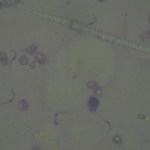Project Overview
This project deals with zoonotic infections amongst livestock and the farmers who keep them. Zoonotic diseases are infections transmitted between animals and humans; they are a major group of pathogens (approximately 60% of all human-infective organisms), with a diversity of animal hosts including wildlife, pets and domestic animals. Domestic livestock (especially cattle and pigs) are an important source of zoonotic infections to humans, due in part to the close interactions between these agricultural animals and the people who keep them. While keeping domestic stock is an important source of rural livelihoods in many countries, these animals may also expose the families who keep them to disease risks. Understanding the interactions between people and their domestic animals, and the transmission of zoonoses between them, is of vital importance in creating the evidence-based disease control policies that are required to protect both human and animal health.
This project addresses a set of hypotheses relating to endemic, neglected zoonoses in livestock and humans in East Africa, and the impact of co-factors (a condition that influences the effects of another condition) on the epidemiology of, and burden imposed by, these diseases. The major objectives are to demonstrate a relationship between co-factors and risk of infection, and to investigate whether interventions aimed at co-factors can affect the risk of infection with the zoonoses.
This epidemiology and public health project involves gaining a comprehensive understanding of the infection history of a large cohort of humans and livestock in a study site in Western Kenya, and is only possible through our excellent collaborations with partners in the region. Environmental, behavioural and social factors that might contribute to exposure are also being explored, and the project provides the framework for the evaluation of a range of diagnostic tests in this setting. Using a range of approaches (including mathematical modelling), the findings will be synthesised to devise cost-effective interventions to improve disease control and development policy.
At our study site, we operate a comprehensive community-based sampling programme, sampling in homestead units. This fieldwork is supported by a full scale diagnostic laboratory facility where we analyse samples of both animal and human origin – we process data collected in the field and process blood and faecal samples from all the participating study subjects; the activity is very much in the spirit of the “One Health” paradigm. We run a comprehensive range of parasitological and serological tests, the results of which are used to inform clinical treatment. Our cold chain allows us to prepare material (blood, serum, faeces) for longer term storage and shipment to our central laboratories at the International Livestock Research Institute and Kenya Medical Research Institute, where a second level of diagnostic effort is applied (ELISA testing, PCR), together with genetic analyses of pathogen and livestock samples, and the quantitative analysis of the field and laboratory data generated



Collaborators
Collaborators on this project include the following institutions:

Media
|
The PAZ project, together with other activities at the International Livestock Research Institute, featured on Australian television in March 2011, on the “Catalyst” science programme. The Catalyst website with the video clip of the programme itself (7mins 49 secs) is embedded below. Press the “play” button on the video to watch it on-line. Enjoy!
|
We highlight that the PAZ project depicted in the programme is funded by the Wellcome Trust in the UK, with additional support from the BBSRC and the MRC, and is a project based at the Centre for Immunity, Infection and Evolution at the University of Edinburgh, in collaboration with the International Livestock Research Institute and the Kenya Medical Research Institute, both in Kenya.
Catalyst on ABC TV: http://www.abc.net.au/catalyst
Producer: Dr Paul Willis
Funding
This project is principally funded by the Wellcome Trust, with additional support from the BBSRC.

Featured Articles



















You must be logged in to post a comment.